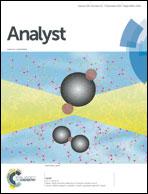Impact of pulse duration on localized single-cell nano-electroporation†
Abstract
We introduce a localized single-cell membrane nano-electroporation with controllable sequential molecular delivery by millisecond to nanosecond electrical pulses. An intense electrical field was generated by a pair of transparent indium tin oxide (ITO)-based nano-electrodes, which was confined to a narrow region of the single-cell membrane surface near the nano-electrode edges (approximately 2 μm × 50 nm area), whereas the remaining area of the membrane was unaffected. Moreover, a 250 nm SiO2 passivation layer on top of the nano-electrode reduced not only the thermal effect on the cell membrane surface, but it also avoided the generation of ions during the experiment, resulting in the reduction of cell toxicity and a significant enhancement of cell viability. Our approach precisely delivers dyes, Quantum Dots (QDs) and plasmids, through a localized region of single HeLa cells by considerably enhanced electrophoresis and diffusion effects with different duration of the pulsing process. The smaller molecules took less time to deliver into a single cell with a single pulse, whereas larger biomolecules took longer time even for multiple numbers of long lasting pulses. The system not only generates sequential well-controlled nano-pores allowing for the rapid recovery of cell membranes, but it also provides spatial, temporal and qualitative dosage control to deliver biomolecules into localized single-cell levels, which can be potentially beneficial for single cell studies and therapeutic applications.


 Please wait while we load your content...
Please wait while we load your content...